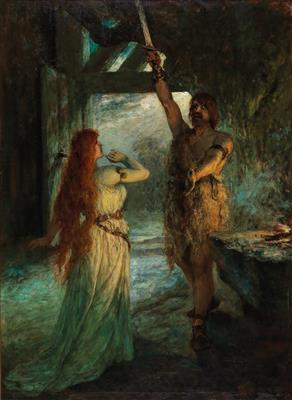Ferdinand Leeke

(Burg, Magdeburg 1859-1923 Nuremberg)
Scene from Richard Wagner’s “Valkyrie” (1st Act: Sieglinde and her brother Siegmund who has drawn the Nothung sword from the ash tree in the room), indistinct signature stamp, oil on canvas, 135 x 100 cm, framed, (Rei)
With the words Whoe'er own this hearth, / here must I rest me, the exhausted Siegmund enters Hunding’s house at the beginning of Act 1 of The Valkyrie, having no idea that he will come upon his sister there: Sieglinde was abducted as an infant and given in marriage to Hunding. She knows little of her family background and does not initially recognise her twin brother.
When Hunding returns home he discovers the enemy whom he has just wanted to fight in battle. However, he is obliged to offer hospitality for one night, even to his enemy, though he challenges Siegmund to a duel the next day: My house protects / you today Wolfing, / I receive you for the night: / with strong weapons / I will fight back tomorrow.
However, Sieglinde feels herself increasingly drawn to the stranger and administers a sleeping potion to her husband. She tries to indicate to Siegmund the trunk of an ash tree in which a sword has been plunged, which, up till now, no-one has been able to pull out.
Siegmund finds himself alone at night in a large room and bemoans his fate:
A sword, my father foretold me, / should serve me in sorest need./ Swordless I come to my foe-man’s house; (...) a wife saw I, wondrous and fair; (...) The woman who holds me chained, / who with sweet enchantment wounds, / in thrall is held by the man / who mocks his weaponless foe.
Suddenly the firelight reveals to him a place in the ash tree’s trunk and Sieglinde enters and tells him about the wondrous sword. They look at each other, recognise that they are twins (You are the image, / that I hold in myself ) and – exhilarated by the mild spring night – become inflamed with passionate fervour.
This is the setting for Leeke’s painting which focuses on the dramatic highpoint of Act 1, Scene 3, in which Siegmund pulls the sword out of the trunk of the ash tree:
Holiest love’s most highest need, / love-longing’s piercing passionate need, / burning bright in my breast, / drives to deeds and death: / Nothung! Nothung! So name I thee, sword.
After he has succeeded in claiming the sword, Siegmund ecstatically stretches his arms out to Sieglinde: Bride and sister / be to thy brother: / then flourish the Wälsungs for aye!
The incestuous and passionate entanglement in Act 1 culminates with these famous closing words. What follows on the stage – and in Leeke’s painting – is omitted and left to the audience’s imagination. Wagner’s final stage directions are also to be understood in this sense: Siegmund draws her to him with raging ardour; she sinks with a cry onto his breast. The curtain falls quickly.
Expert: Mag. Dimitra Reimüller
 Mag. Dimitra Reimüller
Mag. Dimitra Reimüller
+43-1-515 60-355
19c.paintings@dorotheum.at
24.06.2019 - 14:00
- Dosažená cena: **
-
EUR 5.120,-
- Odhadní cena:
-
EUR 4.000,- do EUR 6.000,-
Ferdinand Leeke
(Burg, Magdeburg 1859-1923 Nuremberg)
Scene from Richard Wagner’s “Valkyrie” (1st Act: Sieglinde and her brother Siegmund who has drawn the Nothung sword from the ash tree in the room), indistinct signature stamp, oil on canvas, 135 x 100 cm, framed, (Rei)
With the words Whoe'er own this hearth, / here must I rest me, the exhausted Siegmund enters Hunding’s house at the beginning of Act 1 of The Valkyrie, having no idea that he will come upon his sister there: Sieglinde was abducted as an infant and given in marriage to Hunding. She knows little of her family background and does not initially recognise her twin brother.
When Hunding returns home he discovers the enemy whom he has just wanted to fight in battle. However, he is obliged to offer hospitality for one night, even to his enemy, though he challenges Siegmund to a duel the next day: My house protects / you today Wolfing, / I receive you for the night: / with strong weapons / I will fight back tomorrow.
However, Sieglinde feels herself increasingly drawn to the stranger and administers a sleeping potion to her husband. She tries to indicate to Siegmund the trunk of an ash tree in which a sword has been plunged, which, up till now, no-one has been able to pull out.
Siegmund finds himself alone at night in a large room and bemoans his fate:
A sword, my father foretold me, / should serve me in sorest need./ Swordless I come to my foe-man’s house; (...) a wife saw I, wondrous and fair; (...) The woman who holds me chained, / who with sweet enchantment wounds, / in thrall is held by the man / who mocks his weaponless foe.
Suddenly the firelight reveals to him a place in the ash tree’s trunk and Sieglinde enters and tells him about the wondrous sword. They look at each other, recognise that they are twins (You are the image, / that I hold in myself ) and – exhilarated by the mild spring night – become inflamed with passionate fervour.
This is the setting for Leeke’s painting which focuses on the dramatic highpoint of Act 1, Scene 3, in which Siegmund pulls the sword out of the trunk of the ash tree:
Holiest love’s most highest need, / love-longing’s piercing passionate need, / burning bright in my breast, / drives to deeds and death: / Nothung! Nothung! So name I thee, sword.
After he has succeeded in claiming the sword, Siegmund ecstatically stretches his arms out to Sieglinde: Bride and sister / be to thy brother: / then flourish the Wälsungs for aye!
The incestuous and passionate entanglement in Act 1 culminates with these famous closing words. What follows on the stage – and in Leeke’s painting – is omitted and left to the audience’s imagination. Wagner’s final stage directions are also to be understood in this sense: Siegmund draws her to him with raging ardour; she sinks with a cry onto his breast. The curtain falls quickly.
Expert: Mag. Dimitra Reimüller
 Mag. Dimitra Reimüller
Mag. Dimitra Reimüller
+43-1-515 60-355
19c.paintings@dorotheum.at
|
Horká linka kupujících
Po-Pá: 10.00 - 17.00
kundendienst@dorotheum.at +43 1 515 60 200 |
| Aukce: | Obrazy 19. století |
| Typ aukce: | Salónní aukce |
| Datum: | 24.06.2019 - 14:00 |
| Místo konání aukce: | Wien | Palais Dorotheum |
| Prohlídka: | 15.06. - 24.06.2019 |
** Kupní cena vč. poplatku kupujícího a DPH
Není již možné podávat příkazy ke koupi přes internet. Aukce se právě připravuje resp. byla již uskutečněna.
